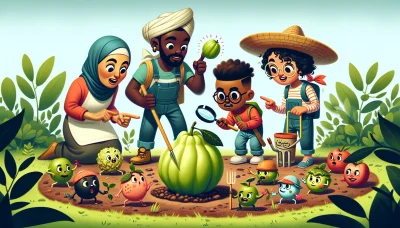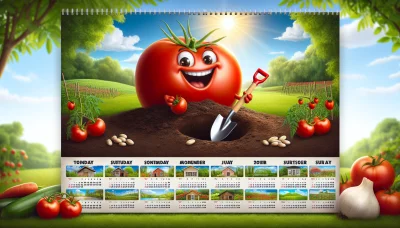Sharon fruit Quiz
Test Your Knowledge
Question of
Introduction to Sharon Fruit
Sharon fruit, also known as Persimmon, is a sweet, flavorful fruit that originated in Asia. It is particularly associated with Japan, China, and Korea, where it has been cultivated for centuries. The Sharon fruit is round or oval and typically has a bright orange skin when ripe. Its flesh can range from firm to mushy, depending on the variety and ripeness. This fruit is unique because it can be eaten in various stages of ripeness, each offering a different taste and texture experience. Sharon fruit is rich in vitamins and minerals, making it a healthy addition to any diet.
The Benefits of Growing Sharon Fruit
Sharon fruit, also known as Persimmon, is a delightful addition to any garden due to its nutritional benefits and ease of cultivation. This fruit is packed with vitamins, particularly A and C, which are essential for immune system support and eye health. Additionally, Sharon fruit is a good source of dietary fiber, aiding in digestion and contributing to heart health. Its sweet, honey-like taste makes it a favorite among many, and its ability to thrive in a variety of climates makes it a practical choice for gardeners looking to diversify their homegrown produce. Growing Sharon fruit can not only enhance your diet but also add beauty to your garden with its vibrant orange fruit and glossy green leaves.
How to Plant Sharon Fruit Trees
- Select a Planting Site - Choose a location that receives full sun and has well-draining soil.
- Test Soil pH - Ensure the soil pH is between 6.0 and 7.5 for optimal growth.
- Prepare the Planting Hole - Dig a hole twice as wide and the same depth as the root ball of your Sharon fruit tree.
- Amend the Soil - If necessary, mix in compost or aged manure to improve soil fertility and structure.
- Plant the Tree - Remove the tree from its container, gently tease the roots, and place it in the hole, making sure the root crown is level with the soil surface.
- Backfill the Hole - Gently fill the hole with soil, tamping down lightly to remove air pockets.
- Water Thoroughly - After planting, water the tree deeply to help settle the soil around the roots.
- Mulch Around the Base - Apply a 2-3 inch layer of mulch around the base of the tree to retain moisture and suppress weeds, keeping the mulch a few inches away from the trunk.
- Stake the Tree if Necessary - If your tree is tall or in a windy location, stake it to prevent wind damage.
- Water Regularly - Water the tree deeply once a week, adjusting based on rainfall, to ensure it gets enough moisture while establishing roots.
Caring for Your Sharon Fruit Tree
To ensure your Sharon Fruit Tree thrives, it's essential to provide it with the right care. This tree prefers full sunlight, so plant it in a spot where it can enjoy unfiltered sunshine for most of the day. When it comes to watering, maintaining a balance is key; the soil should be kept moist but not waterlogged. Overwatering can lead to root rot, while under-watering can stress the tree, affecting fruit production. Fertilization is also an important aspect of care. Use a balanced, slow-release fertilizer in early spring to encourage healthy growth and fruit development. With the right care, your Sharon Fruit Tree will produce delicious fruits for you to enjoy.
Common Pests and Diseases
- Mealybugs: These pests can be controlled by wiping them off with a cotton swab dipped in alcohol or using insecticidal soaps.
- Scale insects: Introduce natural predators like ladybugs or apply horticultural oils during the dormant season to manage these pests.
- Spider mites: Increase humidity around the trees or use miticides as a last resort to control infestations.
- Fruit flies: Use yellow sticky traps to monitor and reduce their populations.
- Anthracnose: This fungal disease can be prevented by ensuring good air circulation around the trees and applying fungicides if necessary.
- Root rot: Improve soil drainage and avoid overwatering to prevent this disease.
- Leaf spot: Remove and destroy infected leaves and apply appropriate fungicides to protect the trees.
Harvesting and Storing Sharon Fruit
Sharon fruits, also known as persimmons, are unique in their harvesting and storage requirements. To determine the right time for harvesting, observe the fruit's color and softness. Ripe Sharon fruits exhibit a deep orange hue and yield slightly under gentle pressure, indicating they are ready to be picked. Post-harvest, it is crucial to handle these fruits with care to avoid bruising. For short-term storage, keep them at room temperature until they reach your desired level of ripeness. For longer storage, refrigerate the fruits to slow down the ripening process, extending their shelf life for several weeks. Remember, Sharon fruits are best enjoyed when fully ripe, offering a sweet and delightful flavor profile.
Sharon Fruit Recipes
| Recipe Name | Ingredients | Preparation |
|---|---|---|
| Sharon Fruit Salad | Sharon fruit, mixed berries, mint, honey | Chop Sharon fruit, mix with berries, garnish with mint, and drizzle with honey. |
| Sharon Fruit Smoothie | Sharon fruit, banana, almond milk, cinnamon | Blend all ingredients until smooth. |
| Baked Sharon Fruit | Sharon fruit, honey, cinnamon, cloves | Halve Sharon fruit, drizzle with honey and spices, bake at 375°F for 25 minutes. |
| Sharon Fruit Salsa | Sharon fruit, red onion, cilantro, lime juice | Dice Sharon fruit and onion, mix with chopped cilantro and lime juice. |
| Sharon Fruit Jam | Sharon fruit, sugar, lemon juice, pectin | Cook Sharon fruit with sugar and lemon juice, add pectin, boil, then cool. |












